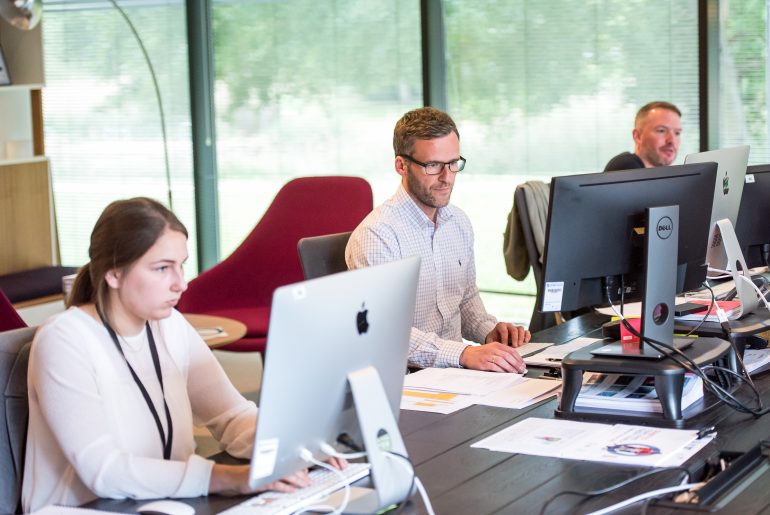The following article was written by Sophie O’Connell and published in Occupational Health and Wellbeing on the 7th June 2019.
The modern world and the constant pursuit of technological growth have almost eliminated the need for movement in our daily lives. While commuting we sit in our cars or on the bus; at work we sit at our computers or in meetings; during our leisure time we sit watching TV, playing computer games or socialising with friends. 
Because of technology advancements we do not even need to leave the comfort of our own homes to socialise, stay in touch with friends and family, to shop, to work or even be entertained on a screen. This means that, on average, Brits spend around 9.5 hours a day spent sitting.
Typically, the amount of time spent sedentary each day increases with age. In working-age adults much of this sitting is done at work. Evidence shows that office-based workers spend around 75% of their working day sitting, with a third of sitting time being done for a prolonged period.
Many of us are guilty of spending time sitting for extended periods due to work, travel or various social commitments. But with the growing evidence demonstrating the health consequences of a sedentary lifestyle, we may need to rethink the way we spend our time – and organisations can play a part in this.
Chronic health conditions
High levels of sitting have been shown to increase the likelihood of developing chronic health conditions or even premature death. Research has demonstrated that you could be twice as likely to develop type 2 diabetes and be at an increased risk of cardiovascular diseases if you sit for long periods. These relationships have been found to exist independent of weight and physical activity levels.
As sitting appears to be the default position for many of us, the thought that it could be so damaging seems absurd. However, when we sit down electrical activity in our major muscles groups (for example our quadriceps and abdominals) shuts down, slowing the body’s capacity for calorie burning.
The level of enzymes that break down fats significantly drop, as does our high-density lipoprotein (good cholesterol). Prolonged sitting also decreases the effectiveness of insulin, meaning blood glucose levels remain higher. So, not only does our metabolism slow down, but our blood glucose levels and blood pressure both increase, leaving us with increased risk of chronic diseases.
 While regular physical activity should always be recommended as a part of a healthy lifestyle, meeting the government guidelines of 150 minutes a moderate-to-vigorous physical activity a week will not eliminate all of the health risks from sitting too much.
While regular physical activity should always be recommended as a part of a healthy lifestyle, meeting the government guidelines of 150 minutes a moderate-to-vigorous physical activity a week will not eliminate all of the health risks from sitting too much.
A recent review Sedentary time in adults and the association with diabetes, cardiovascular disease and death: systematic review and meta-analysis indicated that, if at least 60 minutes of moderate-to-vigorous physical activity a day was achieved, you could alleviate (but may not completely offset) the health risks of a highly sedentary lifestyle. The most recent Health Survey for England found that only 66% men and 58% of women meet the 150 minutes per week physical activity guidelines, so 60 minutes a day could be an unrealistic target for most people.
So, in a world that facilitates sitting in just about every element of daily life, what can be done to reduce the risk of health complications associated with extended periods of sitting? Increasing the levels of physical activity each day will certainly help reduce the risk of chronic illness and will also see a wealth of other benefits including weight loss, improved mood, self-esteem, sleep quality and reduced stress. However, the answer should be reducing the amount of sitting that is done in the first place, instead of finding ways to offset the risks.
There is evidence to suggest that merely breaking up the long periods of sitting we are accustomed to, by standing or moving, is associated with improved health outcomes; particularly adiposity measures, such as waist circumference and BMI, but also triglycerides (fat) and blood sugars.
The evidence around sedentary behaviour and health has recently been reviewed by a panel of experts to generate guidelines to reducing sedentary behaviour and urging employers to change their workplace culture and social norms around the sedentary environment. These guidelines recommend office workers spend at least two hours standing or moving, eventually increasing to four hours.
Avoiding too much sitting, especially for those who drive to an office-based job, is quite a challenge. But with productivity at risk, as well as health, it is vital they try and get up and away from their chairs as much as possible.
The SMArT Work project
In a bid to promote wellbeing at work, office staff at University Hospitals of Leicester NHS Trust have taken part in Stand More AT Work (SMArT Work), a 12-month research project aiming to reduce sitting time in office workers.
The study consisted of a control arm, who continued to work in their usual conditions, and an intervention arm, who received the SMArT Work Intervention.
This included a height-adjustable desk, a seat cushion that monitored their sitting time and prompted them to stand up, a diary and action plan allowing them to set goals and monitor them, feedback on their sitting behaviour, motivational posters to place around their workplace and catch-up discussions with the research team to monitor their progress.
The height-adjustable workstations allow staff to switch between sitting and standing while working at their computers. Staff were also encouraged to think about others ways to reduce their daily sitting time, like standing or walking meetings, taking the stairs whenever possible, speaking to colleagues face-to-face instead of calling or emailing and taking a break from their desk at lunch time. The study’s message is simple: sit less and move more.
At the end of the 12-month trial, there was a significant difference in sitting time between the control participants and intervention participants of 83 minutes. There were also improvements in standing time, job performance, work engagement, occupational fatigue, sickness presenteeism, daily anxiety and quality of life.
This study, along with others, shows that this kind of behaviour can be changed. Organisations should encourage office staff to occasionally stand, but it may take time to make the cultural shift to standing while working.
Employers could invest in height-adjustable desks for their staff, but this could be an expensive option. There are also attachments for desks that allow workers to move their screen and keyboard to a standing position, instead of the whole desk surface. We have also developed a website, www.smartworkandlife.co.uk, based on this study that includes a number of hopefully valuable online toolkits.
Balance between sitting and standing
Of course, standing for extended periods could result in health issues too, so it is important to promote a balance between sitting and standing throughout the day. One way of doing this is providing alternate work spaces, such as standing hot desks that workers can use these for a suitable amount of time and then go back to their standard desk. Employers could also add high tables in meeting rooms or break rooms which encourage standing conversations during break times.
Meetings are the perfect opportunity to engage in some movement. Why not try walking meetings? This way employees increase movement during the day and it will help get their creativity flowing. If there is a larger meeting, why not have standing meetings, or at least standing agenda items? This might take a bit of time for people to adjust to, but will help keep meetings short and to the point.

Personal bins or printers could be removed and placed in a location that inevitably encourages workers to move more. Encourage workplace policies such as no food or drink at your desk, encouraging staff to take breaks, which is vital for reducing stress as well as promotion of movement.
These changes will not be adopted overnight and there will need to be a shift from the thought process of “I must be at my desk to show that I am working”. Staff sat at their desks for hours on end may not be as productive as a worker who regularly gets up and moves and therefore works harder when they are at their desk.
In summary, the technological advancements we have made do support more time sitting. However, we are now realising the damaging effects of this behaviour. It is therefore vital we all think about minimising the amount of sitting we do and encourage one another to move about wherever possible. Every bit of movement, no matter how short in duration, soon adds up and reduces the time spent sedentary.










Comments are closed.